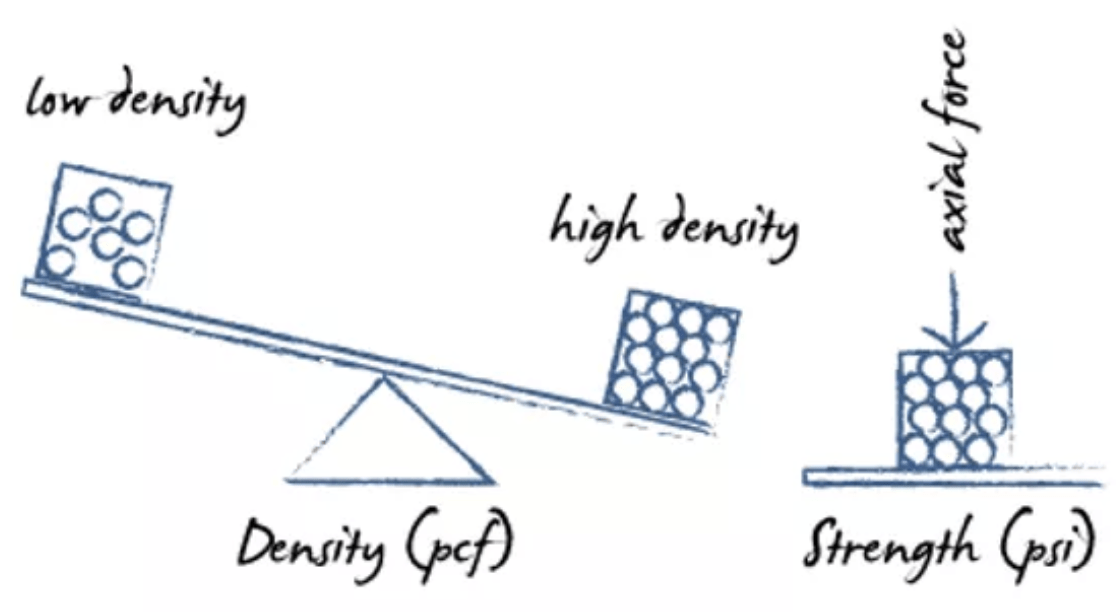Density vs Strength
It’s important to understand the difference between the “Density” and “Strength” of a concrete masonry unit, as the two terms are often misunderstood and incorrectly assumed to be the same. In short, all three “Density” categories of CMU meet the minimum “Strength” requirements as defined by CSA A165.1. To avoid any confusion, it is important to know that every mix design has both a density and a strength. Higher density does not necessarily mean higher strength… in fact, you can select a Lightweight, High Strength mix design, which is stronger than a Medium Weight, Regular Strength mix design. Are you confused yet? The following should help clear things up.


Density
“Density” is another word for “weight”. A concrete “mix design” is measured in in kilograms per cubic metre, (“kg/m3”). . In other words, “How much does one cubic metre of a given mix design weigh, when paced on a scale?”. Standards applicable to CMU include three classifications of weight: Lightweight (“LW”), Medium Weight (“MW”) and Normal Weight (“NW”).

Industry Classification of Density (weight) for Concrete Masonry (as determined by the weight of one cubic metre of the mix design used in a block).
- A· Normal Weight (NW) CMU also called Standard Weight: Weighs 2000kg/m3 or greater.
- B· Medium Weight / Astro Block (as we call it) (MW) CMU: Weighs 1800 to less than 2000kg/m3.
- C· Semi-Light weight CMU : Weighs 1700 to less than 1800 kg/m3
- D· Lightweight (LW) CMU: Weighs less than 1700 kg/m3.
Note that CMU “Weight” does NOT equal CMU “Strength”.
Strength
“Strength,” as related to masonry systems, is expressed in two distinct ways: Compressive Strength of the CMU, and the Specified Compressive Strength of the Masonry System (masonry units + mortar + grout).
The Compressive Strength of CMU is measured in“megapascal”(Mpa). Among the combined strengths of the aggregates, sand and cement, the more important influence on overall compressive strength is the quantity of cement used in the mix, and the time allowed for the block to cure. Generally, the higher the cement content, the higher the strength, and, the longer the CMU cures, the stronger it gets, until it reaches its maximum designed strength (usually about 28 days).
Typically, unit compressive strengths at 28 days can range from 15 MPa to 40 MPa. The availability of this wide range of unit strengths ensures the economic use of concrete masonry over a wide range of applications. and the higher strengths are typically achieved by simply adding more cement to a standard strength mix design. A designer may choose from incremental specified compressive strengths of 10, 15, 20, 30 MPa or greater.
New for REVIT® Users:
Masonry design in REVIT® is easier than ever before!
There is a fantastic new plug-in, called MasonryiQ™, which allows you to load colour and texture options for concrete masonry into a design palette that is project-specific, unleashing you to create unique wall types and calculated blends, using ratios and parameters to better express your ideas. The plug-in also offers intelligent views of corner conditions, section cuts, window and door openings, as well as control joints and bond beams. You will be amazed at how easy it is to iterate your design ideas, inside of REVIT®, and with built-in BIM intelligence like never before.

Materials Used: Ground Face Glacier Concrete Block

Prince George, BC
Materials Used: Ground Face Grey Concrete Block

Science Building
Materials Used: Ground Face 70/30 white Concrete Block

Materials Used: Ground Face Sandstone Concrete Block
